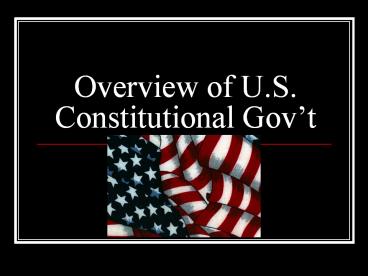Overview of U.S. Constitutional Gov - PowerPoint PPT Presentation
Title:
Overview of U.S. Constitutional Gov
Description:
Overview of U.S. Constitutional Gov t – PowerPoint PPT presentation
Number of Views:102
Avg rating:3.0/5.0
Title: Overview of U.S. Constitutional Gov
1
Overview of U.S. Constitutional Govt
2
Articles and Amendments
- U.S. Constitution consists of
- 7 Articles Art 1 Legis Branch
- Art 2 Exec Branch
- Art 3 Judicial Branch
- 27 Amendments 1st 10 Bill of Rights
3
The Federal System
- System of govt with powers divided between a
strong national govt and the separate state
govts that have some powers of their own
4
The National Govt
Delegated Powers
- Powers that only the national govt may exercise
many are listed in Art I Sect 8 others are
listed throughout the Constitution - Examples only natl govt may regulate foreign
and interstate commerce, coin money, raise an
army and navy, declare war, etc.
5
The State Governments
Reserved Powers
- Powers that only the states may exercise
- Constitutional basis for reserved powers is the
Tenth Amendment - Examples determine marriage and divorce laws
public education conducting elections
6
Concurrent Powers
- Powers that may be exercised by both levels of
govt - Examples the power to tax charter corporations
7
Separation of Powers
- Powers of the natl govt are divided among the 3
branches, each w/ its own area of authority - Legislative makes laws
- Executive executes or enforces laws
- Judicial interprets applies laws
8
Legislative Branch Article I
- Makes laws bills must pass both houses in
identical form before going to Pres. - Bicameral legis U.S. Congress House of Reps
(rep based on pop) Senate (rep equal) - H of R 435 members 2 yr term
- Senate 100 members 6 yr term (1/3 elected
every 2 yrs) - H of R appropriations bills must begin here
chooses Pres if no electoral majority
impeachment - Senate ratifies treaties and approves Pres
appointments tries impeachment cases
9
Executive Branch Art II largest branch
of federal govt
- Executes or enforces the laws
- President, Vice President, Cabinet, federal
agencies (FBI, IRS, EPA, CIA, etc) - Pres must be natural born citizen
- 4 yr term chosen by Electoral College
- Originally no term limit 22 amendment
- Pres is commander in chief of armed forces
10
Judicial Branch Art III
- Interprets and applies federal laws
- All federal judges have life appts may be
impeached - Pres appts Senate approves
- Federal Court system has 3 levels
- District courts 1st level trial courts
- Circuit Courts of Appeal next level
- Supreme Ct highest court in U.S. (9 members)
- (no appeal beyond Sup Ct)
11
Checks and Balances
- Each branch of govt has certain powers it may
use to check or limit the powers of the other
branches - Prevents any 1 branch from gaining too much power
- Makes branches cooperate and work together to get
things done
12
Necessary and Proper ClauseAKA Elastic Clause
- Congress authorized to make all laws which shall
be necessary and proper for carrying into
execution the foregoing powers - This allows the powers of Congress to expand
- This is the basis of the implied powers doctrine
13
Commerce Clause
- Congress authorized to regulate commerce w/
foreign nations and among the several states
(interstate commerce) - Congressional power expanded thro interpretation
/ definition of commerce
14
Supremacy Clause
- The U.S. Constitution, federal laws and treaties
the Senate has ratified are the supreme, or
highest law of the land - They outweigh state laws
- A state judge must overturn any state law that
conflicts w/ the Constitution or with a federal
law
15
The Amendment Process (Art V)
- It is a lengthy and difficult process so the
Constitution will be changed only for major
reasons of national importance and not for
frivolous reasons - It is a 2-step process involving Congress and the
states - Many more amendments have been proposed than have
been ratified
16
2 Methods of Proposal
- 1. By 2/3 majority in both houses of Congress
- 2. In national convention called at request of
2/3 of the state legislatures (this method has
never been used)
17
2 Methods of Ratification
- 1. By ¾ of the state legislatures (all except
one have been ratified this way) - 2. In special ratification conventions in ¾ of
the states (21st Amend repeal of prohibition
ratified this way)
18
The Bill Of Rights
- First 10 amendments proposed by the 1st
Congressadded to the Constitution in 1791 - Protects Americans civil liberties 1st Amend
freedoms rights of the accused right to
privacy protections of property protections
against double jeopardy and cruel and unusual
punishment etc.
19
The First Amendment Freedoms
- freedom of religion, speech, press
- the right of the people to peaceably assemble
- the right to petition the govt for redress of
grievances































